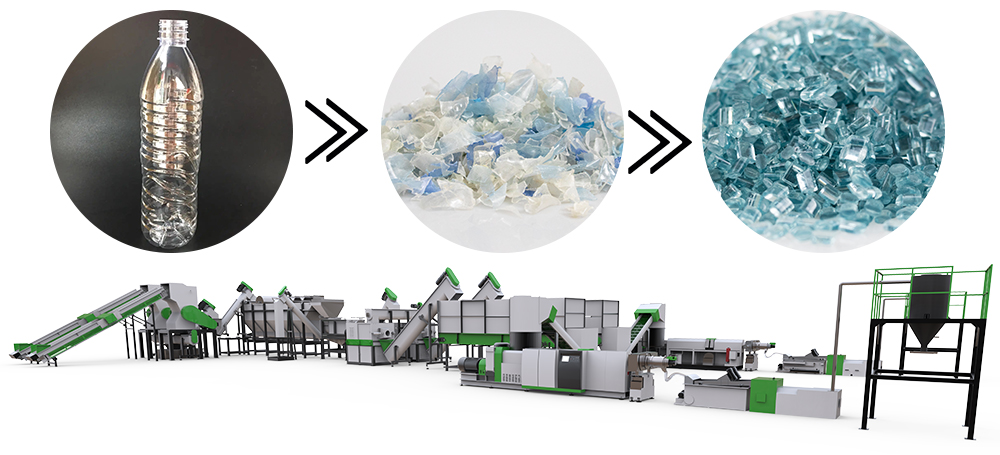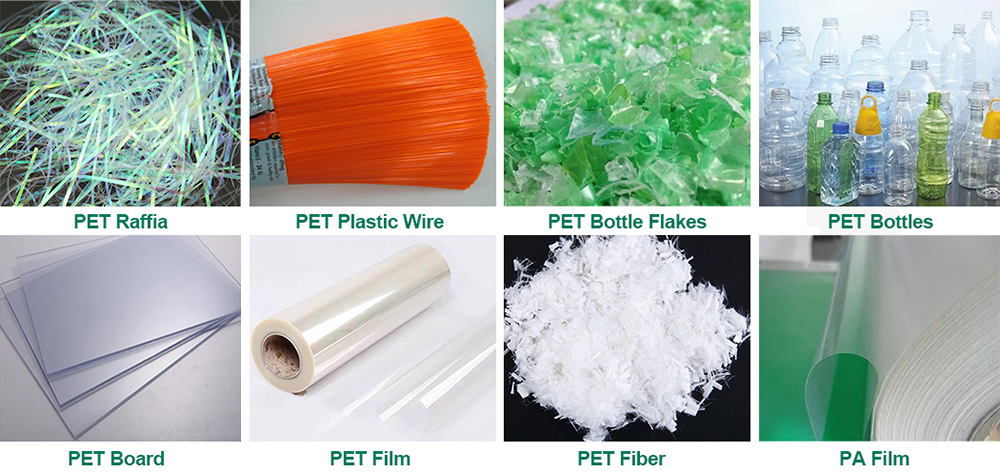Article paragraph
Ⅰ Characteristics of PET plastic bottles
Ⅱ PET plastic bottle recycling method
Ⅲ The use of PET plastic bottles after recycling
PET plastic bottle characteristics
Polyethylene terephthalate is the most important variety of thermoplastic polyester, English name Polythylene terephthalate referred to as PET or PETP (hereinafter referred to as PET), commonly known as polyester resin. It is a polycondensate of terephthalic acid and ethylene glycol, and together with PBT, it is collectively referred to as thermoplastic polyester, or saturated polyester. PET is a milky white or light yellow highly crystalline polymer with a smooth and shiny surface.
It has good creep resistance, fatigue resistance, friction resistance and dimensional stability, low wear and high hardness, and has the greatest toughness among thermoplastics; good electrical insulation performance, little effect of temperature, but poor corona resistance. Non-toxic, weather resistant, good chemical stability, low water absorption, weak acid and organic solvent resistance
Pet plastic bottles are the most widely used beverage packaging. In addition to the daily packaging of carbonated beverages, fruit juices, tea beverages, etc., they are also widely used in many fields such as food, medicine, and chemical industry. PET plastic has a wide range of applications in the packaging field, whether it is packaging film, roll material, or beer bottles, PET plastic is used. But when these materials are discarded, there is the question of what to do with them. The recycling of PET plastic bottles can not only solve environmental protection problems, but also can be used as a new raw material resource to alleviate the contradiction of the global shortage of PET raw materials.
PET plastic bottle recycling method
1. Physical recycling method 1 - shredding waste PET plastic bottles into pieces
The physical recycling method of PETt plastic bottles is relatively simple, mainly drying and granulating the cleaned and discarded pet plastic bottles. Cut waste PET plastic bottles into pieces, separate HDPE, aluminum, paper and adhesive from PET, and then wash, dry and pelletize the PET fragments.
2. Physical recovery method 2 - first separation and then processing
First, the impurities such as caps, caps and labels that are not PET on the discarded PET plastic bottles are separated by mechanical methods, and then washed and dried, usually using a centrifugal dehydrator to reduce the moisture content of the fragments to 2%. Dry in a tubular dryer to reduce the moisture content to 0.5% and granulate.
3. Chemical recycling methods
A method of depolymerizing waste PET plastic bottles under certain reaction conditions to generate useful chemicals, such as the production of low-grade fuel gasoline.
Использование гранул ПЭТ после физической или химической переработки следующее:
1. Для повторного производства пластиковых бутылок ПЭТ переработанные гранулы не могут использоваться в прямом контакте с пищевыми продуктами, но могут использоваться в среднем слое трехслойных пластиковых бутылок ПЭТ, а затем превращаться в бутылки для газированных напитков.
2. Прядение для изготовления волокон, переработанные материалы ПЭТ могут использоваться для изготовления волокон, которые могут использоваться в качестве спальных мешков, матрасов, сердцевин подушек, войлоков и т. д.
3. Армированный стекловолокном материал, армированный стекловолокном переработанный ПЭТ обладает хорошей термостойкостью и механической прочностью и может использоваться для изготовления автозапчастей, таких как термостойкие автомобильные колпаки колес.
4. Модификация смешивания, переработанный материал ПЭТ можно смешивать с другими полимерами для получения различных модифицированных материалов, таких как смешивание с ПЭ, можно получить смеси ПЭТ с улучшенными ударопрочностью; если добавить немного полипропилена, можно значительно улучшить размерную стабильность смесей. Поскольку полярности ПЭ и ПЭТ совершенно разные, во время смешивания требуется обработка для обеспечения совместимости. Как правило, совместимость улучшается за счет привитой модификации полиолефина.
5. Выброшенные пластиковые бутылки ПЭТ обрабатываются и перерабатываются. Помимо возможности изготовления пластиковых бутылок ПЭТ, их также можно использовать для изготовления спальных мешков, сердцевин подушек, чехлов для автомобильных колес и т. д. Мировое потребление пластиковых бутылок ПЭТ очень велико. Пластиковые бутылки ПЭТ можно перерабатывать и превращать отходы в сокровище, что не только решает проблему нехватки сырья ПЭТ, но и снижает загрязнение окружающей среды и отходы ресурсов, что приносит большую пользу устойчивому развитию. Его технология переработки имеет очень широкие перспективы.
Каковы методы переработки и применения пластиковых бутылок ПЭТ после переработки
2021/03/03
входит в Новости отрасли